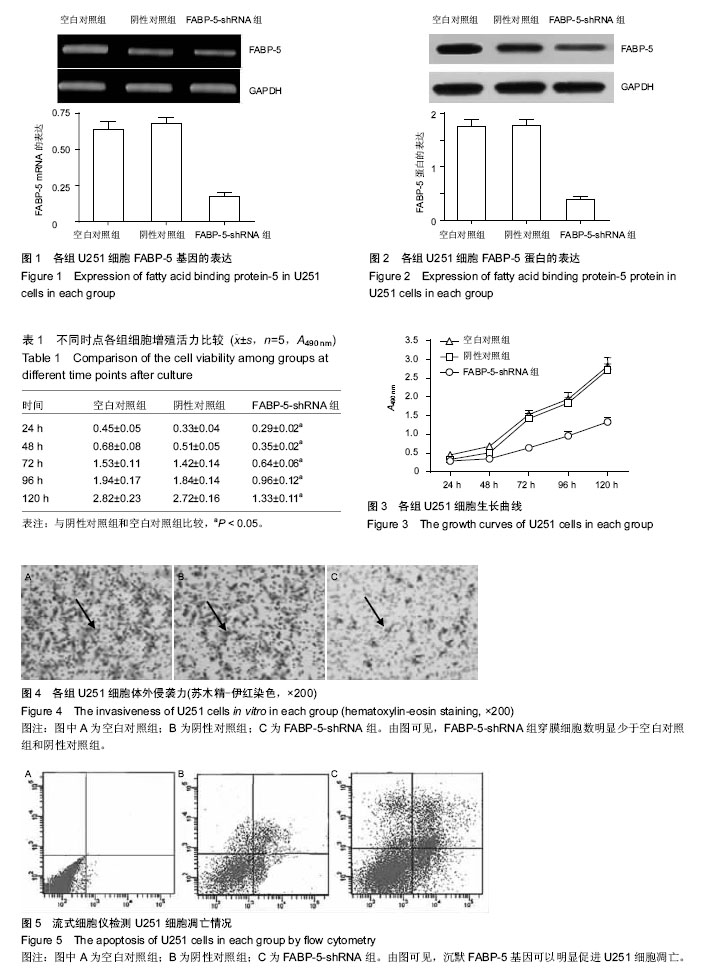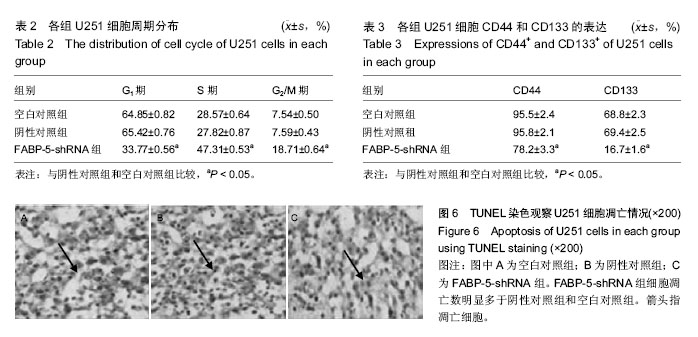中国组织工程研究 ›› 2016, Vol. 20 ›› Issue (28): 4142-4148.doi: 10.3969/j.issn.2095-4344.2016.28.006
• 肿瘤干细胞 cancer stem cells • 上一篇 下一篇
FABP-5基因沉默对人胶质瘤细胞增殖、侵袭、凋亡及肿瘤干细胞标志物CD44+CD133+表达的影响
刘海鹏,王冀伟,郑克彬
- 河北大学附属医院神经外科,河北省保定市 071000
Effects of fatty acid binding protein-5 silencing on proliferation, apoptosis, invasion of human glioma cells and expressions of CD44+ and CD133+
Liu Hai-peng, Wang Ji-wei, Zheng Ke-bin
- Department of Neurosurgery, Affiliated Hospital of Hebei University, Baoding 071000, Hebei Province, China
摘要:
文章快速阅读:
.jpg)
文题释义: 表皮型脂肪酸结合蛋白5:是在表皮细胞中发现的脂肪酸结合蛋白,其分子质量为15 ku,在肿瘤发生及发展中发挥关键的作用。肿瘤相关的上皮细胞黏附分子可以使FABP-5基因表达上调,高表达FABP-5基因的肿瘤细胞通过脂肪酸代谢产物影响细胞的信号转导功能。 肿瘤干细胞:肿瘤中具有自我更新能力并能产生异质性肿瘤细胞的细胞。传统观念认为,肿瘤是由体细胞突变而成,每个肿瘤细胞都可以无限制地生长,但这无法解释肿瘤细胞似乎具有无限的生命力以及并非所有肿瘤细胞都能无限制生长的现象。肿瘤细胞生长、转移和复发的特点与干细胞的基本特性十分相似,因此,有学者提出肿瘤干细胞的理论,这一理论为重新认识肿瘤的起源和本质提供了新的方向和视觉角度。
摘要 背景:已有研究表明,FABPs在多种恶性肿瘤,包括乳腺癌、前列腺癌、肝癌、肺癌、膀胱上皮癌都有不同程度的表达,与恶性肿瘤的发生、转移、侵袭和抗药性关系密切。 目的:探讨沉默FABP-5基因表达对人胶质瘤细胞U251增殖、侵袭、凋亡的影响。 方法:以人胶质瘤细胞U251细胞为研究对象,根据FABP-5 mRNA编码序列设计并合成干扰siRNA序列,瞬时转染U251细胞。将人胶质瘤细胞U251分为3组:FABP-5-shRNA组加入Lv-shRNA-FABP-5,阴性对照组加入LV-shRNA-NC,空白对照组仅行常规培养。RT-PCR和Western blot法分别从mRNA和蛋白水平检测FABP-5的表达,CCK-8法测定细胞体外增殖能力,流式细胞仪检测细胞周期、细胞凋亡及肿瘤干细胞标志物CD44+CD133+的表达,TUNEL染色检测细胞凋亡。 结果与结论:①与阴性对照组和空白对照组比较,FABP-5-shRNA组的FABP-5 mRNA和蛋白表达明显下降;②与阴性对照组和空白对照组比较,FABP-5-shRNA组细胞生长速度明显减慢,细胞周期阻滞在G0/G1期,S期细胞数减少;肿瘤干细胞标志物CD44+CD133+的表达比例亦显著降低(P < 0.05);③与阴性对照组和空白对照组相比,FABP-5-shRNA组细胞凋亡率明显升高(P < 0.01),增殖、侵袭力显著下降(P < 0.05);④结果表明,FABP-5基因可能直接或间接地参与到胶质瘤细胞周期的调控和凋亡过程,其基因的表达水平改变与肿瘤细胞侵袭力关系密切。
中图分类号:


.jpg)